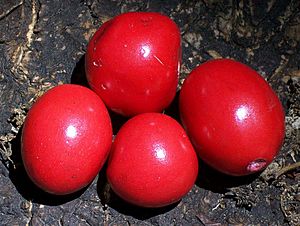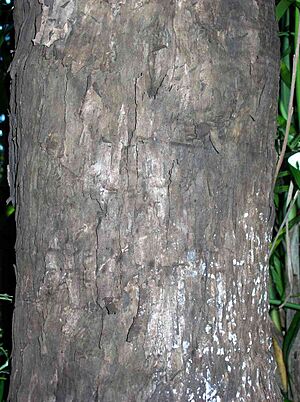Red-fruited ebony facts for kids
Quick facts for kids Red-fruited ebony |
|
|---|---|
 |
|
| Red-fruited ebony | |
| Conservation status | |
| Scientific classification | |
| Genus: |
Diospyros
|
| Species: |
mabacea
|
| Synonyms | |
|
|
The red-fruited ebony (scientific name: Diospyros mabacea) is a very rare rainforest tree. It belongs to the ebony or persimmon family. This special tree grows in the northeastern part of New South Wales, Australia. Sadly, it is listed as an endangered species, which means it is at risk of disappearing forever.
Contents
Where the Red-Fruited Ebony Lives
This unique tree is found in only a few places. There are just thirteen known spots where it grows naturally. These areas are in subtropical rainforests near the towns of Murwillumbah and Mullumbimby in New South Wales. It prefers to grow in low-lying areas.
Threats to Its Home
Sadly, much of the red-fruited ebony's original home has been destroyed. This happened because land was cleared for farming and building houses. Today, the trees that are left face new dangers.
- Invasive Plants: Other plants, especially fast-growing vines, can take over and harm the young ebony trees.
- Cattle: On private land, cattle can accidentally step on and damage young seedlings.
It's possible that this tree once grew in the nearby Gold Coast area. However, a lot of building happened there in the mid-1900s. This development might have caused the tree to disappear from that region.
Growing in Botanic Gardens
It is rare to see a fully grown red-fruited ebony tree in its natural environment. Luckily, some of these trees are planted in special botanic gardens across Australia. It's even thought that some of these trees might only exist today because people have planted them.
What the Red-Fruited Ebony Looks Like
The red-fruited ebony is a small to medium-sized tree. It can grow up to 25 meters (about 82 feet) tall. Its main stem can be about 30 centimeters (about 12 inches) wide.
Trunk and Bark Features
The tree's trunk is dark and looks almost "hairy." It has rough, grayish-brown bark that peels off in uneven pieces. The bottom of the tree is not very wide or strong-looking. Sometimes, the trunk can be a bit bent or crooked. If you look under the bark, the wood often appears a creamy color.
Leaves of the Tree
The leaves of the red-fruited ebony are usually 6 to 15 centimeters (about 2.4 to 6 inches) long. They are also 2 to 5 centimeters (about 0.8 to 2 inches) wide. The underside of the leaves is lighter in color than the top. Like other Diospyros trees, the leaves grow one after another along the stem.
Flowers and Fruit Life Cycle
Small flowers appear on the tree in September. After the flowers, red fruit starts to grow between January and March. This fruit looks a bit like a cherry tomato but can come in different shapes. Some are round, others are egg-shaped, long and thin, or even flat like a small pumpkin.
The fruit can be up to 4.5 centimeters (about 1.8 inches) long. Inside, the flesh is whitish and dry. It doesn't have much taste and isn't good to eat. Each fruit usually holds two to six seeds. These seeds are brown, curved, and have a triangular shape when you look at them from the end.
How the Tree Reproduces
Growing new red-fruited ebony trees from seeds is a slow and difficult process. It takes a long time, and it's not always successful.
The Tree's Name
The scientific name mabacea comes from a Latin word. It means "resembling Maba." This is because the plant was first placed in a different group of plants called Maba. The very first sample of this tree was collected by a botanist named Charles Moore. He found it near the Tweed River.
Images for kids





